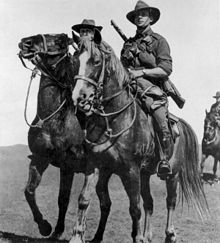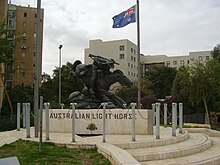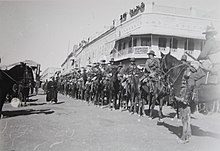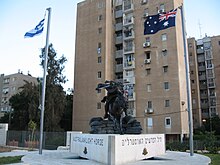
The Australian and New Zealand Mounted Division was a mounted infantry division of the British Empire during World War I. The division was raised in March 1916 and was assigned to the I ANZAC Corps. On establishment, it consisted of four brigades comprising three Australian Light Horse and one New Zealand mounted rifles, supported by British horse artillery. In 1917, one of the Australian brigades was replaced by a British yeomanry brigade. After April 1917, the standard order of battle was reduced to two Australian brigades and one New Zealand brigade, although the Imperial Camel Corps Brigade and other British mounted brigades were temporarily attached several times during operations.
The Australian Mounted Division originally formed as the Imperial Mounted Division in January 1917, was a mounted infantry, light horse and yeomanry division. The division was formed in Egypt, and along with the Anzac Mounted Division formed part of Desert Column, Egyptian Expeditionary Force in World War I. The division was originally made up of the Australian 3rd Light Horse Brigade, the reconstituted 4th Light Horse Brigade, and two British yeomanry brigades; the 5th Mounted Brigade and 6th Mounted Brigade.

The Battle of Beersheba was fought on 31 October 1917, when the British Empire's Egyptian Expeditionary Force (EEF) attacked and captured the Ottoman Empire's Yildirim Army Group garrison at Beersheba, beginning the Southern Palestine Offensive of the Sinai and Palestine campaign of World War I.

The 2nd/14th Light Horse Regiment is a regiment of the Australian Army and forms part of the Royal Australian Armoured Corps. The regiment is an Australian Light Horse unit, and has been widely romanticised and popularised in literature and poetry throughout the 20th century. The unit sentimentally traces its lineage to 1860 and is the oldest Australian Regular Army unit through antecedent units the 2nd Moreton Light Horse (QMI) and the 14th West Moreton Light Horse (QMI). The regiment is assigned to 7th Brigade based in Brisbane and is equipped with the Boxer Combat Reconnaissance Vehicle, the ASLAV Reconnaissance Vehicle and the M1A1 Abrams main battle tank.

The 3rd Brigade is a combined arms brigade of the Australian Army, principally made up of the 1st and 3rd Battalions of the Royal Australian Regiment. Initially raised in 1903 as part of the post-Federation Australian Army, it was removed from the order of battle in 1906 following the restructure of the field force. It was re-formed in 1914 for service during World War I, taking part in the fighting at Gallipoli and on the Western Front in Europe. During World War II the brigade was used in a defensive role before it was disbanded in 1944. It was re-raised in 1967 for service during the Vietnam War and later went on to provide the nucleus of the deployment to East Timor during the Australian-led intervention in 1999. The brigade is currently based at Lavarack Barracks in Townsville, Queensland.

The 1st Light Horse Brigade was a mounted infantry brigade of the Australian Imperial Force (AIF), which served in the Middle Eastern theatre of World War I. The brigade was initially formed as a part-time militia formation in the early 1900s in New South Wales and then later in Queensland. In 1914, the brigade was re-constituted as part of the AIF and was sent to Egypt. Forming part of the New Zealand and Australian Division, during the Gallipoli Campaign it served in a dismounted role between May and December 1915. After being withdrawn to Egypt it served in the Anzac Mounted Division from March 1916 as part of the Egyptian Expeditionary Force, taking part in the Sinai and Palestine Campaign until the end of the war. It was disbanded in 1919. After the war, the AIF light horse regiments were demobilised and disbanded; however, the brigade briefly existed as a part-time militia formation in Queensland until 1921 when its regiments were reorganised into cavalry brigades.

The 2nd Light Horse Brigade was a mounted infantry brigade of the Australian Imperial Force (AIF) which served in the Middle Eastern theatre of World War I. The brigade was initially formed as a part-time militia formation in the early 1900s in New South Wales. In 1914, the brigade was re-constituted as part of the AIF. The brigade first saw action while serving in the Australian and New Zealand Army Corps (ANZAC) during the Gallipoli campaign. After being withdrawn to Egypt in February 1916 they served in the ANZAC Mounted Division from March 1916 as part of the Egyptian Expeditionary Force during the Sinai and Palestine Campaign until the end of the war. After the war, the AIF light horse regiments were demobilised and disbanded; however, the brigade briefly existed as a part-time militia formation in New South Wales until 1921 when its regiments were reorganised into cavalry brigades.

The 3rd Light Horse Brigade was a mounted infantry brigade of the Australian Imperial Force (AIF), which served in the Middle Eastern theatre of World War I. The brigade was initially formed as a part-time militia formation in the early 1900s in Victoria. In 1914, the brigade was re-constituted as part of the AIF. The brigade first saw action while serving with the Australian and New Zealand Army Corps during the Gallipoli campaign where they were noted for their attack during the Battle of the Nek. After being withdrawn to Egypt in February 1916 they were involved in the Sinai and Palestine Campaign until the end of the war. They were attached to a number of different formations being part of the Anzac Mounted Division in March 1916 and the Australian Mounted Division in June 1917, who they remained with until the end of the war. After the war, the AIF light horse regiments were demobilised and disbanded; however, the brigade briefly existed as a part-time militia formation in New South Wales until 1921 when its regiments were reorganised into cavalry brigades.

The 4th Light Horse Brigade was a mounted infantry brigade of the Australian Imperial Force (AIF) serving in the Middle Eastern theatre of World War I. The brigade was initially formed as a part-time militia formation in the early 1900s in Victoria and Tasmania. After the outbreak of World War I, the brigade was raised as a volunteer formation within the AIF in March 1915 and shipped to Egypt and was broken up in August 1915 to provide dismounted reinforcements to other light horse formations already deployed to Gallipoli. Reformed in February 1917, the brigade was assigned to the Imperial Mounted Division, which formed part of the Egyptian Expeditionary Force, and in June 1917 transferred to the Australian Mounted Division, where it served in the Sinai and Palestine Campaign until the end of the war. After the war, the AIF light horse regiments were demobilised and disbanded; however, the brigade briefly existed as a part-time militia formation in New South Wales until 1921 when its regiments were reorganised into cavalry brigades.

The 5th Light Horse Brigade was a mounted infantry brigade of the First Australian Imperial Force (AIF) that served during World War I. The brigade was initially formed as a part-time militia formation in the early 1900s in Queensland. During World War I, the brigade was formed in Palestine in July 1918 following the disbandment of the Imperial Camel Corps. At this time, the brigade consisted of two Australian Light Horse regiments and a French cavalry regiment, and was supported by British and New Zealand artillery and machine gun troops. It served in the Middle Eastern theatre of World War I in the Sinai and Palestine Campaign as part of the Australian Mounted Division, but only saw limited operations before the war ended, taking part in the capture of Damascus in September and October 1918. After the war, the AIF light horse regiments were demobilised and disbanded; however, the brigade briefly existed as a part-time militia formation in Victoria until 1921 when its regiments were reorganised into cavalry brigades.

The 14th Light Horse Regiment was a mounted infantry or light horse unit of the Australian Army. The unit takes its lineage from units raised as part of the colonial forces of the state of Queensland in 1860 and served during the Second Boer War and World War I. In 1930 it was amalgamated with the 2nd Light Horse Regiment to become the 2nd/14th Light Horse Regiment, a unit that continues to exist as part of the Australian Army today.

The Battle of el Buqqar Ridge took place on 27 October 1917, when one infantry regiment and cavalry troops of the Yildirim Army Group, attacked the 8th Mounted Brigade of the Egyptian Expeditionary Force (EEF) in the last days of the stalemate in Southern Palestine during the Sinai and Palestine campaign of World War I.

The 3rd Light Horse Regiment was a mounted infantry regiment of the Australian Army during the First World War. The regiment was raised in September 1914, and by December as part of the 1st Light Horse Brigade had moved overseas. The regiment only fought against the forces of the Ottoman Empire, in Egypt, at Gallipoli, on the Sinai Peninsula, and in Palestine and Jordan. After the armistice the regiment eventually returned to Australia in March 1919. For its role in the war the regiment was awarded nineteen battle honours.

The 4th Light Horse Regiment was a mounted infantry regiment of the Australian Army during the First World War. The regiment was raised in August 1914, as the divisional cavalry regiment for the 1st Division. The regiment fought against the forces of the German Empire and the Ottoman Empire, in Egypt, at Gallipoli, on the Western front, on the Sinai Peninsula, and in Palestine and Jordan. After the armistice the regiment eventually returned to Australia in March 1919. For its role in the war the regiment was awarded twenty-one battle honours.

The 11th Light Horse Regiment was a mounted infantry regiment of the Australian Army during the First World War. The regiment was raised in August 1914, and assigned to the 4th Light Horse Brigade. The regiment fought against the forces of the Ottoman Empire, in Egypt, at Gallipoli, on the Sinai Peninsula, and in Palestine and Jordan. After the armistice the regiment eventually returned to Australia in March 1919. For its role in the war the regiment was awarded fourteen battle honours. During the inter-war years, the regiment was re-raised as a part-time unit based in the Darling Downs region of Queensland. It was later converted to a motor regiment during the Second World War but was disbanded in 1943 without having been deployed overseas.

The Desert Column was a First World War British Empire army corps which operated in the Sinai and Palestine Campaign from 22 December 1916. The Column was commanded by Lieutenant General Philip W. Chetwode and formed part of Eastern Force. When Chetwode took command of Eastern Force after the Second Battle of Gaza, Harry Chauvel took command and oversaw the expansion of the column to three divisions.

The Stalemate in Southern Palestine was a six-month standoff between the British Egyptian Expeditionary Force (EEF) and the Ottoman Army in World War I. The two hostile forces faced each other along the Gaza to Beersheba line during the Sinai and Palestine Campaign, with neither side able to force its opponent to withdraw. The stalemate began in April 1917 with the defeat of the EEF by the Ottoman Army at the Second Battle of Gaza and lasted until the EEF offensive began with the Battle of Beersheba on 31 October 1917.
The Southern Palestine offensive, began on 31 October 1917, with the Battle of Beersheba, when the British Empire's Egyptian Expeditionary Force (EEF) under the Command of Field Marshall Edmund Allenby attacked Ottoman Empire forces at the Palestinian town of Beersheba during the Sinai and Palestine Campaign, of World War I. After the capture of Beersheba, by the EEF, the Gaza to Beersheba line became increasingly weakened and, seven days later, the EEF successfully forced the Ottoman Turkish Empire's Seventh and Eighth Armies to withdraw. During the following seven days of pursuit, the Turkish forces were pushed back to Jaffa. There followed three weeks of hard fighting in the Judean Hills before Jerusalem was captured on 9 December 1917. During five and a half weeks of almost continuous offensive operations, the EEF captured 47.5 miles (76.4 km) of territory.
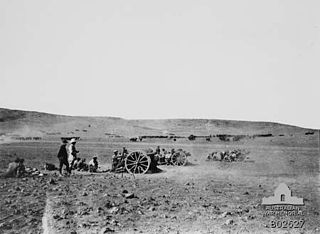
The Battle of Tel el Khuweilfe, part of the Southern Palestine Offensive, began on 1 November 1917, the day after the Egyptian Expeditionary Force (EEF) victory at the Battle of Beersheba during the Sinai and Palestine Campaign of World War I. After the Stalemate in Southern Palestine a series of coordinated attacks were launched by British Empire units on the Ottoman Empire's German commanded Yildirim Army Group's front line, which stretched from Gaza inland to Beersheba. During the fight for the town, the road from Beersheba to Jerusalem via Hebron, was cut just north of the town in the southern spur of the Judean Hills. Here Ottoman units strongly defended the road and the Seventh Army headquarters at Hebron.
The Structure of the Egyptian Expeditionary Force over the course of the First World War is shown below.
